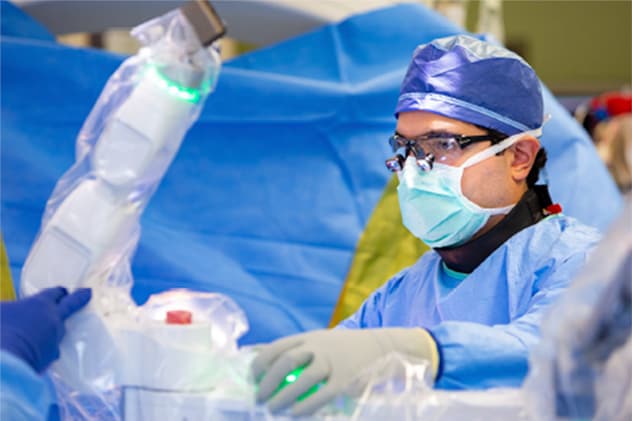Feb. 16, 2021
Accurate placement of pedicle screws is key to avoiding the potential complications of spinal fusion surgery and improving overall spinal fixation. Mayo Clinic uses the latest robot-assisted technology when indicated to enhance surgical precision in these procedures.
"Robot-guided surgery is a well-choreographed process that can help ensure reliable and accurate placement of spinal implants," says Brett A. Freedman, M.D., an orthopedic surgeon at Mayo Clinic in Rochester, Minnesota. "We find that this system offers distinct advantages compared with not only freehand placement but also standard stereotactic navigation."
Mayo Clinic was an early adopter of robot-assisted technology for spinal fusion surgery. As an orthopedic center of excellence, Mayo is committed to new technology that provides clinical benefits and adds value. "Robot-assisted surgery is just one example," Dr. Freedman says. "We continually look for validated innovations that help our patients."
Ideal paths and trajectories
Cirugía de la columna vertebral con la nueva tecnología guiada por robot

Cirugía de la columna vertebral con la nueva tecnología guiada por robot
El Dr. Mohamad Bydon, neurocirujano de Mayo Clinic en Rochester, Minnesota, dirige un equipo que realiza una cirugía de la columna vertebral utilizando una nueva tecnología guiada por robot.
Robot-assisted spine surgery uses CT imaging and navigational software to determine the optimal pathway for inserting pedicle screws. Finding that pathway is made challenging by the lack of clearance around the spine and the presence of surrounding neurological structures.
"Robotic assistance gives us real-time imaging that reliably depicts complex anatomy," Dr. Freedman says. "That's very important when a patient has not only deformity that changes the shape of bone but also poor-quality bone. We can actually find a path that goes through the patient's best bone as opposed to softer bone."
During surgery, the system's software guides the robotic arm into position, translating the surgical plan onto the surgical field. "The robotic arm places the guidance tube in the preferred alignment, and each screw can then be placed to a depth and in an alignment that matches its mates, which makes for a better overall construct," Dr. Freedman says. "A system that robotically aligns the screws' trajectories makes it easier to insert the spinal rods and induces less stress on the screws we placed."
In addition, the robotic arm's stability overcomes problems inherent with standard stereotactic navigation. "Stereotactic navigation requires the surgeon's hands to be held in a specific position that is mapped to the imaging. However, our hands move — especially when we are preparing and inserting screws — while the robot holds a rock-steady trajectory," Dr. Freedman says. "Our arms and other appendages are also in the way of the tracking camera that watches the various surgical instruments move. The robot-assisted system gives us an enhanced path of navigation."
Mayo Clinic continuously assesses new technologies to determine their benefits for patients. "As spine surgeons, we want to innovate to solve problems, validate these solutions, and research the impact they have on clinical outcomes and value-based care," Dr. Freedman says. "Robotic assistance offers real advantages for the accurate placement of pedicle screws."